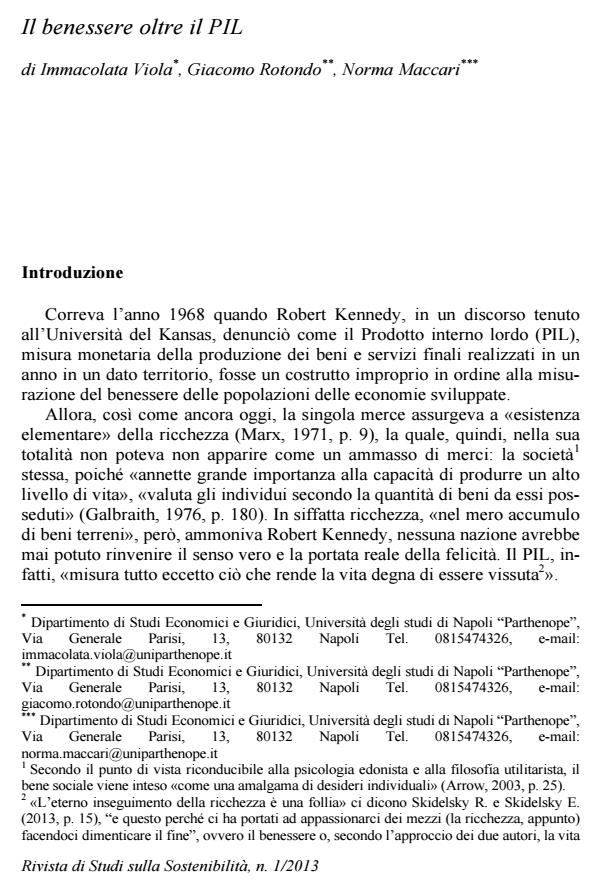The well-being beyond GDP
Journal title RIVISTA DI STUDI SULLA SOSTENIBILITA'
Author/s Immacolata Viola, Giacomo Rotondo, Norma Maccari
Publishing Year 2013 Issue 2013/1 Language Italian
Pages 18 P. 9-26 File size 214 KB
DOI 10.3280/RISS2013-001002
DOI is like a bar code for intellectual property: to have more infomation
click here
Below, you can see the article first page
If you want to buy this article in PDF format, you can do it, following the instructions to buy download credits

FrancoAngeli is member of Publishers International Linking Association, Inc (PILA), a not-for-profit association which run the CrossRef service enabling links to and from online scholarly content.
The concept of the so-called "going beyond the GDP" have been generated by the latest international debates about the multidimensional assessment of wellbeing. In other words, the attention should be posed not only on assets, for which the GDP it is still a valid proxy, but also on all that factors responsible for life quality. In addition to this it is necessary to analyze these well-being dimensions in a perspective view of sustainability in such a manner to understand if will be possible to keep intact the current levels of well-being for the future generations. The goal of the following review is to analyze the issues of material conditions, life quality and sustainability starting from Recommendations of the Report by the Stiglitz Commission published in 2009, then executed by OECD in the How’s Life? Measuring well-being Report in 2011 and also executed by ISTAT in collaboration with CNEL in the Benessere Equo e Sostenibile Report published in Italy in 2013.
Keywords: Material conditions, quality of life, GDP, well-being, sustainability, dimensions.
- Stiglitz J. E., Sen A., Fitoussi J-P (2010). La misura sbagliata delle nostre vite. Perché il PIL non basta più per valutare benessere e progresso sociale. Milano: ETAS.
- Stiglitz J. E., Sen A., Fitoussi J-P (2009). Report by the Commission on the Measurement of Economic Performance and Social Progress.
- Tiezzi E., Bastianoni S., Marchettini N., Pulselli F. M. (2011). La soglia della sostenibilità. Quello che il PIL non dice. Roma: Donzelli Editore.
- UNDP (1990). Human Development Report, Oxford University Press. www.borsaitaliana.it.
- Stiglitz J.E., Amartya S., Fitoussi J. (2012). La misura sbagliata delle nostre vite. Perché il PIL non basta più per valutare benessere e progresso sociale. Milano: ETAS.
- Skidelsky R., Skidelsky E. (2013). Quanto è abbastanza. Di quanto denaro abbiamo davvero bisogno per essere felici? (Meno di quello che pensi). Milano: Mondadori,
- Osberg L., Sharpe A. (2005). How should we measure the economic aspects of well-being?. Review of Income and Wealth, Series 51, 2: 311-336, DOI: 10.1111/j.1475-4991.2005.00156.x
- Osberg L., Sharpe A. (2002). An index of economic well-being for selected OECD countries. Review of Income and Wealth, Series 48, 3: 291-316, DOI: 10.1111/1475-4991.00056
- OECD (2011b). Compendium of OECD well-being indicators. OECD Publishing.
- OECD (2011a). How’s Life? Measuring well-being. OECD Publishing.
- Nussbaum M. C. (2012). Creare capacità. Liberarsi dalla dittatura del PIL. Bologna: il Mulino, Bologna.
- Nordhaus W. D., Tobin J. (1972). Is Growth Obsolete?, Economic Research, Retrospect and Prospect Vol. 5, Economic Growth, pg. 1-80, NBER.
- Marx K. (1971). Per la critica dell’economia politica. Roma: Editori Riuniti.
- ISTAT e CNEL (2013). Benessere equo e sostenibile in Italia.
- Giovannini E. (2010). Dal PIL al benessere: nuovi indicatori per misurare il progresso della società. Libertà e benessere: L’Italia al futuro, Confindustria. http://web.worldbank.org/.
- Galbraith J. K. (1976). La società opulenta. Torino: Universale scientifica Boringhieri.
- Gadrey J., Jany-Catrice F. (2005). No PIL! Contro la dittatura della ricchezza. Roma: Castelvecchi.
- Daly H. E., Cobb J. B. (1994). Un’economia per il bene comune. Como: RED.
- Daly H. E. (1996). Beyond Growth. Boston: Beacon Press.
- Cesaretti G.P. (2011). L’approccio della Fondazione Simone Cesaretti alla Sostenibilità dello Sviluppo umano. Rivista di studi sulla sostenibilità, 1: 11-13.
- Bartolini S. (2010). Manifesto per la felicità. Come passare dalla società del ben-essere a quella del ben-avere. Roma: Donzelli Editore.
- Arrow K. J. (2003). Scelte sociali e valori individuali. Milano: ETAS.
- Circular economic analysis for Sustainability Gian Paolo Cesaretti, Irene Paola Borrelli, Immacolata Viola, in RIVISTA DI STUDI SULLA SOSTENIBILITA' 1/2021 pp.201
DOI: 10.3280/RISS2021-001012 - Transition towards Well-being Sustainability:Approach to "Circular Economic Model" Nicola Marinelli, Gian Paolo Cesaretti, Immacolata Viola, in RIVISTA DI STUDI SULLA SOSTENIBILITA' 2/2022 pp.263
DOI: 10.3280/RISS2021-002019
Immacolata Viola, Giacomo Rotondo, Norma Maccari, Il benessere oltre il PIL in "RIVISTA DI STUDI SULLA SOSTENIBILITA'" 1/2013, pp 9-26, DOI: 10.3280/RISS2013-001002